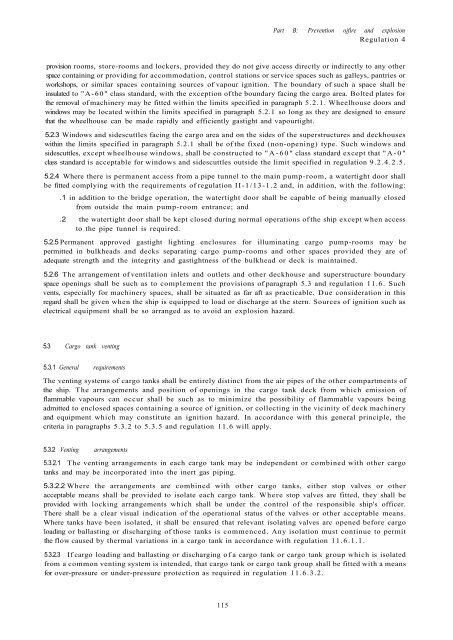Solas Consolidated Edition 2009.pdf
Solas Consolidated Edition 2009 for maritime
Solas Consolidated Edition 2009 for maritime
Create successful ePaper yourself
Turn your PDF publications into a flip-book with our unique Google optimized e-Paper software.
Part B: Prevention ojfire and explosion<br />
Regulation 4<br />
provision rooms, store-rooms and lockers, provided they do not give access directly or indirectly to any other<br />
space containing or providing for accommodation, control stations or service spaces such as galleys, pantries or<br />
workshops, or similar spaces containing sources of vapour ignition. The boundary of such a space shall be<br />
insulated to "A-60" class standard, with the exception of the boundary facing the cargo area. Bolted plates for<br />
the removal of machinery may be fitted within the limits specified in paragraph 5.2.1. Wheelhouse doors and<br />
windows may be located within the limits specified in paragraph 5.2.1 so long as they are designed to ensure<br />
that the wheelhouse can be made rapidly and efficiently gastight and vapourtight.<br />
5.2.3 Windows and sidescuttles facing the cargo area and on the sides of the superstructures and deckhouses<br />
within the limits specified in paragraph 5.2.1 shall be of the fixed (non-opening) type. Such windows and<br />
sidescuttles, except wheelhouse windows, shall be constructed to "A-60" class standard except that "A-0"<br />
class standard is acceptable for windows and sidescuttles outside the limit specified in regulation 9.2.4.2.5.<br />
5.2.4 Where there is permanent access from a pipe tunnel to the main pump-room, a watertight door shall<br />
be fitted complying with the requirements of regulation II-1/13-1.2 and, in addition, with the following:<br />
.1 in addition to the bridge operation, the watertight door shall be capable of being manually closed<br />
from outside the main pump-room entrance; and<br />
.2 the watertight door shall be kept closed during normal operations of the ship except when access<br />
to the pipe tunnel is required.<br />
5.2.5 Permanent approved gastight lighting enclosures for illuminating cargo pump-rooms may be<br />
permitted in bulkheads and decks separating cargo pump-rooms and other spaces provided they are of<br />
adequate strength and the integrity and gastightness of the bulkhead or deck is maintained.<br />
5.2.6 The arrangement of ventilation inlets and outlets and other deckhouse and superstructure boundary<br />
space openings shall be such as to complement the provisions of paragraph 5.3 and regulation 11.6. Such<br />
vents, especially for machinery spaces, shall be situated as far aft as practicable. Due consideration in this<br />
regard shall be given when the ship is equipped to load or discharge at the stern. Sources of ignition such as<br />
electrical equipment shall be so arranged as to avoid an explosion hazard.<br />
5.3 Cargo tank venting<br />
5.3.1 General requirements<br />
The venting systems of cargo tanks shall be entirely distinct from the air pipes of the other compartments of<br />
the ship. The arrangements and position of openings in the cargo tank deck from which emission of<br />
flammable vapours can occur shall be such as to minimize the possibility of flammable vapours being<br />
admitted to enclosed spaces containing a source of ignition, or collecting in the vicinity of deck machinery<br />
and equipment which may constitute an ignition hazard. In accordance with this general principle, the<br />
criteria in paragraphs 5.3.2 to 5.3.5 and regulation 11.6 will apply.<br />
5.3.2 Venting arrangements<br />
5.3.2.1 The venting arrangements in each cargo tank may be independent or combined with other cargo<br />
tanks and may be incorporated into the inert gas piping.<br />
5.3.2.2 Where the arrangements are combined with other cargo tanks, either stop valves or other<br />
acceptable means shall be provided to isolate each cargo tank. Where stop valves are fitted, they shall be<br />
provided with locking arrangements which shall be under the control of the responsible ship's officer.<br />
There shall be a clear visual indication of the operational status of the valves or other acceptable means.<br />
Where tanks have been isolated, it shall be ensured that relevant isolating valves arc opened before cargo<br />
loading or ballasting or discharging of those tanks is commenced. Any isolation must continue to permit<br />
the flow caused by thermal variations in a cargo tank in accordance with regulation 11.6.1.1.<br />
5.3.2.3 If cargo loading and ballasting or discharging of a cargo tank or cargo tank group which is isolated<br />
from a common venting system is intended, that cargo tank or cargo tank group shall be fitted with a means<br />
for over-pressure or under-pressure protection as required in regulation 11.6.3.2.<br />
115


